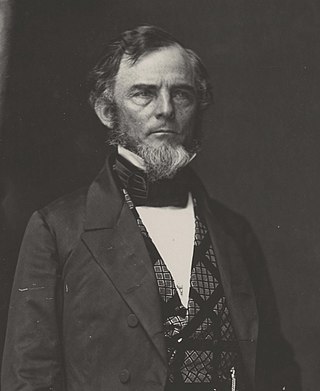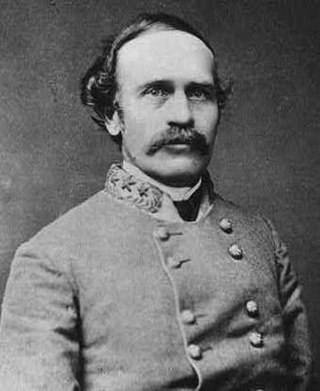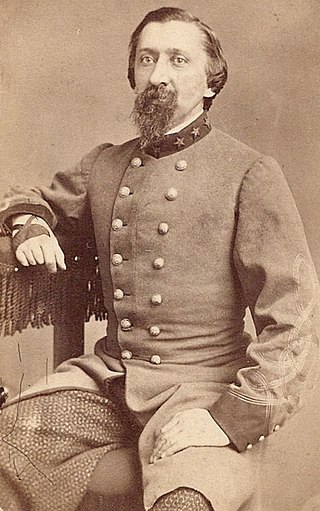
The following Confederate Army units and commanders fought in the Battle of Fort Donelson of the American Civil War. Order of battle compiled from the army organization, [1] and the reports. [2] The Union order of battle is listed separately.

The following Confederate Army units and commanders fought in the Battle of Fort Donelson of the American Civil War. Order of battle compiled from the army organization, [1] and the reports. [2] The Union order of battle is listed separately.
General Albert Sidney Johnston Not present at battle
BG Bushrod Johnson Feb 9
BG Gideon J. Pillow Feb 9-13
BG John B. Floyd Feb 13-16
BG Gideon J. Pillow Feb 16
BG Simon B. Buckner, Sr. Feb 16
| Division | Brigade | Regiments and Others |
|---|---|---|
Right Wing | 2nd Brigade
|
|
| 3rd Brigade
|
| |
Left Wing | 1st Brigade
|
|
| 2nd Brigade
|
| |
| 3rd Brigade
|
| |
| 4th Brigade (Fort Donelson Garrison) [4]
|
| |
| 5th Brigade |
| |
| 6th Brigade
|
| |
| 7th Brigade |
| |
Attached Units | Cavalry Brigade
|
|
| Artillery
|
|

Albert Sidney Johnston was an American military officer who served as a general in three different armies: the Texian Army, the United States Army, and the Confederate States Army. He saw extensive combat during his 34-year military career, fighting actions in the Black Hawk War, the Texas-Indian Wars, the Mexican–American War, the Utah War, and the American Civil War.

Fort Donelson was a fortress built early in 1862 by the Confederacy during the American Civil War to control the Cumberland River, which led to the heart of Tennessee, and thereby the Confederacy. The fort was named after Confederate general Daniel S. Donelson.

Simon Bolivar Buckner was an American soldier, Confederate soldier, and politician. He fought in the United States Army in the Mexican–American War. He later fought in the Confederate States Army during the American Civil War. After the war, he served as the 30th governor of Kentucky.

The Battle of Fort Henry was fought on February 6, 1862, in Stewart County, Tennessee, during the American Civil War. It was the first important victory for the Union and Brig. Gen. Ulysses S. Grant in the Western Theater.

The Battle of Fort Donelson was fought from February 11–16, 1862, in the Western Theater of the American Civil War. The Union capture of the Confederate fort near the Tennessee–Kentucky border opened the Cumberland River, an important avenue for the invasion of the South. The Union's success also elevated Brig. Gen. Ulysses S. Grant from an obscure and largely unproven leader to the rank of major general, and earned him the nickname of "Unconditional Surrender" Grant.
Fort Donelson National Battlefield preserves Fort Donelson and Fort Heiman, two sites of the American Civil War Forts Henry and Donelson Campaign, in which Union Army Brigadier General Ulysses S. Grant and Flag Officer Andrew Hull Foote captured three Confederate forts and opened two rivers, the Tennessee River and the Cumberland River, to control by the Union Navy. The commanders received national recognition for their victories in February 1862, as they were the first major Union successes of the war. The capture of Fort Donelson and its garrison by the Union led to the capture of Tennessee's capital and industrial center, Nashville, which remained in Union hands from February 25, 1862, until the end of the war, and gave the Union effective control over much of Tennessee. This struck a major blow to the Confederacy early in the war.

Gideon Johnson Pillow was an American lawyer, politician, speculator, slaveowner, United States Army major general of volunteers during the Mexican–American War and Confederate brigadier general in the American Civil War.

John Pope Cook was an Illinois politician and a general in the Union Army during the American Civil War. He served in the Western Theater and played a prominent role in securing the Union victory at the Battle of Fort Donelson, helping to force the surrender of the defenders.

John Buchanan Floyd was the 31st Governor of Virginia, U.S. Secretary of War, and the Confederate general in the American Civil War who lost the crucial Battle of Fort Donelson.

Bushrod Rust Johnson was a Confederate general in the American Civil War and an officer in the United States Army. As a university professor he had been active in the state militias of Kentucky and Tennessee and on the outbreak of hostilities he sided with the South, despite having been born in the North in a family of abolitionist Quakers. As a divisional commander he managed to evade capture at the Battle of Fort Donelson, but was wounded at the Battle of Shiloh. He served under Robert E. Lee throughout the 10-month Siege of Petersburg, and surrendered with him at Appomattox.

John Alexander McClernand was an American lawyer, politician, and a Union Army general in the American Civil War. He was a prominent Democratic politician in Illinois and a member of the United States House of Representatives before the war. McClernand was firmly dedicated to the principles of Jacksonian democracy and supported the Compromise of 1850.
The following Union Army units and commanders fought in the Battle of Fort Donelson of the American Civil War. Order of battle compiled from the casualty returns, and the reports. The Confederate order of battle is listed separately.
The 8th Kentucky Infantry Regiment was an infantry regiment that served in the Confederate States Army during the American Civil War.
Charles Carroll Marsh was a Union Army officer during the American Civil War. He served with distinction early in the war at the battles of Fort Donelson and Shiloh. He is commonly referred to as "C. Carrol Marsh" in official reports.
Joseph Drake lawyer and plantation owner, was a Colonel in the Confederate States Army during the American Civil War, who commanded a brigade in two major battles. He was also a member of the Mississippi Legislature before and during the war.

Isham Nicholas Haynie (1824-1868) was a lawyer, politician, soldier and officer in the Union Army during the American Civil War. He was colonel of the 48th Illinois Volunteer Infantry Regiment at the battles of Fort Donelson and Shiloh.
Kendall D. Gott is an Army veteran of Desert Storm, the Senior Historian at the US Army Combat Studies Institute, and author of several works. He is most noted academically as a Civil War and general military history historian, and is a frequent speaker at various Civil War roundtables and staff rides.
The 1st Mississippi Infantry Regiment (Simonton's/Johnston's) was a line infantry regiment of the Confederate States Army formed from companies in north Mississippi. The regiment was first organized in the summer and late fall of 1861. The unit fought primarily in the western theater of the war. Many men from the regiment were recruited from Itawamba County in Mississippi.

Augustus Forsberg (1832-1910) was a Swedish military engineer who emigrated to the United States in 1855. First settling in Charleston, South Carolina, he had strong sympathies for the Southern cause. When the Civil War began, he joined the Confederacy and was commissioned to the rank of lieutenant in the regular Confederate army 1861. Attached to the 51st Virginia Volunteer Infantry, he was elected its lieutenant colonel when the regiment was reorganized in the spring of 1862. Subsequently, promoted to its colonel, he commanded a brigade at the end of the war. Wounded at Winchester in 1864, he became a prisoner-of-war at Waynesboro in 1865. Once released, he ventured to Lynchburg, Virginia, to marry the woman he had met while recovering. They settled and made a family in the town, and Forsberg served as Lynchburg's city engineer for over twenty years.

The 7th Texas Infantry Regiment was a unit of Confederate States Army infantry volunteers organized in 1861 that fought mostly in the Army of Tennessee during the American Civil War. The regiment was captured at Fort Donelson in 1862 and sent to Northern prison camps. After the survivors were exchanged and new recruits added, the regiment was reconstituted and fought at Raymond, Jackson, Chickamauga, Missionary Ridge, and Ringgold Gap in 1863. The unit served in the Atlanta Campaign and at Franklin, Nashville, Averasborough, and Bentonville in 1864–1865. The regiment's 65 survivors surrendered to William Tecumseh Sherman's Federal forces on 26 April 1865.